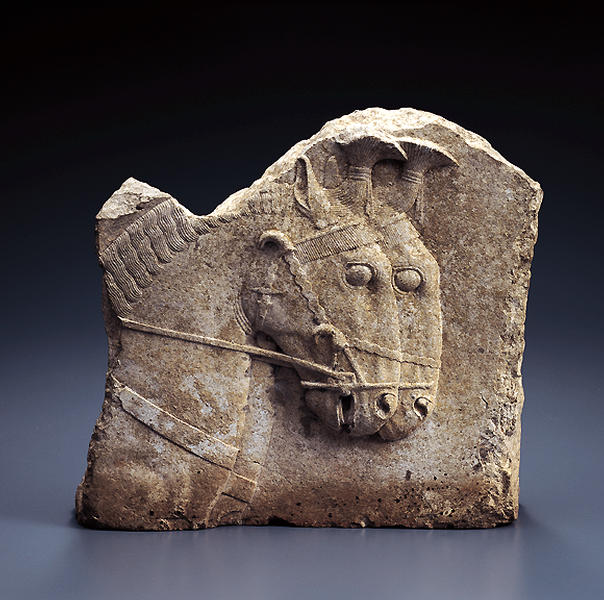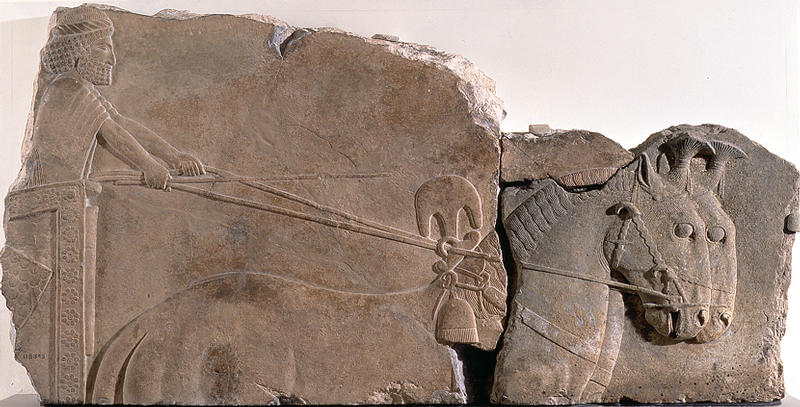二頭の馬浮彫
- イラン ペルセポリス
- アケメネス朝ペルシア
- 前522-前465年
- 石灰岩
- H-37.7 D-9 W-38.1
アケメネス朝第三代のダレイオス大王はスサにつぎペルセポリスに宮殿を建設した。この浮彫は恐らくそのアパダナ北階段の東側を飾って居たと想像される。そこには諸国から奉納品が届けられる場面が描かれているが、その中の王の馬車を引く馬の頭部であろう。前髪を括った髷、波打つ鬣、馬勒に付けられた角様の装飾など、ペルセポリスの馬の特徴を表わしている。
ペルシャのはじまり
紀元前7世紀末から6世紀初頭にかけて、メソポタミアの最大の帝国アッシリアとその最大のライバル、ウラルトゥは、あいついで北西イランのメディアと南メソポタミアのバビロニアの同盟勢力のもとに降り、更にそのイラン系メディアは西アジア世界を初めて統一する大帝国となりました。
イラン系メディアは程なく東南イランの大きい同盟勢力であったイラン系ペルシャに取って替わられ、アケメネス朝ペルシャが立ちました。
紀元前8-7世紀のこの混沌とした時代を通じて、これらメディア、ペルシャなどのイラン民族は好戦的な神々を仰ぐ伝統的な宗教から、秩序と正義そして平和をもたらす世界の救世主をあおぐゾロアスター教に急速に転向して行きました。
彼らは世界を善悪の対立としてとらえ、最終的に善の勝利としての審判が到来するとする終末論から、現実の世界の変容を求めました。
それは絶対善の創造神アフラ・マズダーのもとに統一された世界、アフラ・マズダーから多くの者の中の唯一の王となされた王を頂く巨大帝国をつくりあげることであったと言えます。
Mary Boyce/ A History of Zoroastrianism/ Leiden I- 1996-172ff. , II- 1982- 105 ff.
ペンダント付トルク
宝飾品ー腕輪、トルク、イヤリング、首飾、指輪印章他
有翼獣文様鉢
鴨装飾ブレスレット
鴨装飾ブレスレット
馬形リュトン
帝王闘争文様鉢
獅子頭形杯
ライオングリフィン形リュトン
メディア人従者浮彫
帝都建設の銘文
――そして此は私がスサに建てた宮殿。その資材は遠方より齎された。地面を地中の岩盤まで深く掘り下げた。土を取り除くと砂利が敷き詰められ、あるところは40キュビットあるいは20キュビットに達した。宮殿はこの砂利の上に建てられたのである。地中深く掘り、砂利を敷き詰め、泥煉瓦を作る―――――これら全ての作業はバビロニア人が行った。 杉材はレバノンの山からアッシリア人がバビロンまで運び、カリア人イオニア人がスサまで運んだ。シッソ材はガンダーラとカルマニアから、ラピス・ラズリ、カーネリアンの準貴石はソグディアナから。トルコ石はホラズム、銀とエボニー材はエジプト、壁の装飾はイオニア、象牙はエチオピア(クシュ)やインドそしてアラコジア、石柱はエラムのアビラドゥから運ばれた。石職人はイオニア人、リディア人。金細工師、象嵌細工師はメディア人、エジプト人。バビロニア人は煉瓦を焼き、メディア人、エジプト人は壁を装飾した。 このスサにすばらしいものを建てんとし、すばらしいものができた。願わくばアフラマツダの神が私、父ウィスタシュパそして我が同胞をみそなわし賜わんことを。
Walter Hintz/ The Elamite Version of the Record of Darius's Palace at Susa / 1950 Journal of Near Eastern Studies Vol.IX No.1
ペンダント付トルク
宝飾品ー腕輪、トルク、イヤリング、首飾、指輪印章他
有翼獣文様鉢
鴨装飾ブレスレット
鴨装飾ブレスレット
馬形リュトン
帝王闘争文様鉢
獅子頭形杯
有翼山羊装飾ブレスレット
獅子頭装飾ブレスレット
双獅子頭装飾ブレスレット
ライオングリフィン形リュトン
メディア人従者浮彫
帝都の建設
アケメネス朝の第三代をついだダレイオス大王は、それまでの王宮のあったパサルガダエの北西、アッシリアによって滅ぼされたエラム王国の古都スサに冬の王宮を建てました。
残された銘文には多くの民族がこの王宮の建設に携わったことが強調されています。
これに続き王はパサルガダエのすぐ南ペルセポリスに秋の王宮と言われる都を築きました。
王宮址の階段壁面の浮彫には諸王からの献上品を持った長い行列が描かれています。
Walter Hintz/ The Elamite Version of the Record of Darius's Palace at Susa / 1950 Journal of Near Eastern Studies Vol.IX No.1
メディア人従者浮彫
大王の馬
この浮彫はペルセポリスの王宮を飾りました。ダレイオス大王の戦車を牽く二頭の馬の横顔をあらわしていますが、御者は南イランのエラム人であると言われています。
この馬の横顔は前髪を束ねた髷を立てている様と、猪牙型の手綱具が特徴的です。
同時代のリュトンにはこの同じ特徴を持った馬の装飾がなされているものも見られます。
大王はこの秋の王宮を作る時、それに先だって作った冬の王宮スサと同じように、諸属州からの人材と資材を集めたと考えられますが、この宮殿の装飾彫刻にはギリシャ系の工人が宛てられたと考えられます。
Catalogue Entry
Through a series of dramatic building projects, Darius I (r. 522-486 B.C.), the successor to Cyrus the Great, firmly established the characteristics of Persian art and architecture under the Achaemenid dynasty. The most notable of his commissions was begun in 518 B.C. -Persepolis, a royal residential palace constructed on a broad terrace, with an enormous columned assembly hall or apadana. During following decades, Persepolis was enlarged with a series of independent, yet complementary buildings, constructed largely by his son, Xerxes (r. 486-465 B.C.), and grandson, Artaxerxes I (r. 465/4-425 B.C.).
Originally about twelve buildings were constructed on the Persepolis terrace, with elegantly carved reliefs adorning fa軋des, imposing stairways, doors, and window jambs. The predominant theme is the glorification of the king--who is shown in repetitive scenes walking through the palace, enthroned, or receiving tribute from international delegations from regions of the empire.
This fragment of relief from the Shumei collection was probably part of the East Wing of the monumental Northern Stairway of the apadana begun during the reign of Darius and completed by Xerxes, in about 470 B.C.1 The elaborate scenes of this stairway depict the Persian king receiving tribute from twenty-three delegations of foreign subjects, including among many others, Lybians, Syrians, Egyptians, Elamites, and Medes. Flanking the king are his attendants, guards, grooms, and royal chariots. The Shumei relief joins a larger fragment (88 x 56 cm) now in the British Museum2 that shows the backs of two horses and a chariot and driver. Both fragments probably came from the rearmost chariot from the East Wing of the Northern Stairway.3 A nearly identical chariot and driver depicted in mirror image remains in situ on the Eastern Stairway of the apadana, where the scenes of delegations and royal attendants are reversed.4
The two chariot horses of the Shumei fragment are exquisitely rendered, with great attention to modeling and the fine detail of trappings. They may be identified as Nesaean horses,5 a small compact breed characterized by a strongly arched neck and depicted during the Achaemenid period on stone reliefs, architectural sculpture, and precious objects (see cat. no. 35). As in other examples from Persepolis,6 the horses are shown with forelocks tied into standing tufts with twice-bound ribbons, an upright mane indicated by ornamentalized wavy strands, and sharply carved parallel creases at the juncture of the neck. In the Shumei relief, the horn-shaped attachments of the bridle7 are attached to wavy straps, the throatlash bears an elaborate toggle, and the browband is further enhanced with a line of fringe. The cheekpieces are straight, with rectangular rein attachments and figured ends in the form of hooves. The artist successfully conveys the impression of depth through high relief and naturalistic modeling of the horses, and attention to subtle details such as the clear depiction of the far rein of the first horse, visible between the horse's neck and body.
This fragment was probably acquired at Persepolis in July 1811, by Sir Gore Ousely, British Ambassador to Teheran (1810-15). It was donated by an heir, Sir Frederick Ousely, to St. Michael's College, Tenbury.8 Upon the closure of the college in 1985, the piece was consigned to auction at the Leominster sale of Russel, Baldwin, and Bright in May 1990, and later to Sotheby's in December 1990.9
NT
1. Roaff 1983, p. 138.
2. London, British Museum 118843: Barnett 1957, pl. xv (3). I am very grateful to have received this information and the detailed provenance of the Shumei relief from Dr. John E. Curtis, keeper of the Department of Western Asiatic Antiquities of the British Museum, personal correspondence, 28 February 1997.
3. For extant wall with lower portions of scene see Schmidt 1953, pl. 57.
4. Schmidt 1953, pl. 52; or Walser 1966, pl. 85 (upper).
5. Littauer and Crouwel 1979, pp. 148-49, fig. 80.
6. Roaff 1983, pp. 38-40, pl. XIIa-e.
7. These attachments have been identified by M.A. Littauer and J.H. Crouwel as "birds' beaks or boars' tusks" (Littauer and Crouwel 1979, p. 151) and are represented by excavated finds at Persepolis in Carnelian, white chalk, and limestone (Schmidt 1957, pl. 79.3-5).
二頭の馬浮彫
彼らは羊のような頭を持つ西イラン・メディア原産のニサイアの馬。ペルシア王の馬車を牽く。都ペルセポリスの宮殿に小アジアのギリシア人が刻んだその姿は、皮肉なことにペルシアの滅亡とともに風化することなく地中に保存された。古くからにニサイアの馬はユーラシア東西の心を集めた。後に漢の武帝が「天馬」と呼んで熱望した結果、“シルクロード”誕生の一役を担うことになったのもこのニサイアの馬である。
Relief with Two Horses
The sheep-resembling heads are of Nisean horses, a breed native to the Media region of Western Iran, drawing the chariot of the Persian king. The images the Greek artisans of Asia Minor carved for the palace at Persepolis were ironically preserved in the earth, their contours unchanged despite the fall of the Persian empire. The Nisean horse was greatly treasured in Eurasia, both east and west, and it was to play an important role in the birth of the Silk Road after Emperor Wu of the Han dynasty named it the "heavenly horse" (Ch. tianma).

